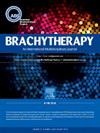子宫内膜癌高剂量率阴道袖带近距离放疗后的胃肠道和泌尿生殖系统毒性。
IF 1.7
4区 医学
Q4 ONCOLOGY
引用次数: 0
摘要
目的:目前辅助HDR阴道袖带近距离放疗(VBT)没有危险器官剂量限制。本研究评估OAR剂量学及其与急性和慢性胃肠道(GI)或泌尿生殖系统(GU)毒性的关系。方法:回顾在单一机构接受3次VBT治疗的患者,每周两次,每次5mm深度,并基于ct的3D计划。记录OAR剂量(D2cc、D1cc和D0.1cc)。急性和慢性毒性按照不良事件通用术语标准v5.0进行分级。箱线图和Wilcoxon-Mann-Whitney试验比较了剂量阈值。结果:177例I-IV期子宫内膜癌患者接受的直肠、乙状结肠、小肠和膀胱的平均D2cc为5.7 Gy(范围:2.8-8.7)、3.3 Gy(0.6-9.3)、3.8 Gy(0.0-9.1)和5.4 Gy(2.0-8.2)。总体而言,6.2% (n = 11)和7.3% (n = 13)的患者出现了任何级别的急性GI和GU毒性。14.7% (n = 26)和14.7% (n = 26)的患者分别出现任何级别的慢性GI和GU毒性。有两种3级毒性,包括一种慢性胃肠道和一种急性胃肠道。未发现与急性或慢性毒性较高可能性相关的剂量学因素。结论:3fx 21 Gy VBT后胃肠道和谷室毒性总体发生率较低,且不存在与毒性相关的剂量学参数。平衡高局部控制与最小毒性的最佳剂量分级时间表尚未确定。本文章由计算机程序翻译,如有差异,请以英文原文为准。
Gastrointestinal and genitourinary toxicity following high dose rate vaginal cuff brachytherapy for endometrial cancer
PURPOSE
There are currently no organs at risk dose constraints for adjuvant HDR vaginal cuff brachytherapy (VBT). This study evaluates OAR dosimetry and the association with acute and chronic gastrointestinal (GI) or genitourinary (GU) toxicity.
METHODS
Patients treated at a single institution with VBT of 21 Gray (Gy) in 3 fractions (Fx) prescribed to 5 mm depth twice weekly and CT-based 3D planning were reviewed. OAR doses (D2cc, D1cc, and D0.1cc) were recorded. Acute and chronic toxicities were graded by Common Terminology Criteria for Adverse Events v5.0. Boxplot and Wilcoxon–Mann–Whitney tests compared dose thresholds.
RESULTS
177 patients with stage I–IV endometrial cancer received a mean D2cc to rectum, sigmoid, small bowel, and bladder of 5.7 Gy (range: 2.8–8.7), 3.3 Gy (0.6–9.3), 3.8 Gy (0.0–9.1), and 5.4 Gy (2.0–8.2). Overall, 6.2% (n = 11) and 7.3% (n = 13) of patients experienced acute GI and GU toxicity of any grade. 14.7% (n = 26) and 14.7% (n = 26) of patients experienced chronic GI and GU toxicity of any grade, respectively. There were two grade 3 toxicities include one chronic GI and one acute GU. No dosimetric factors were identified that correlated with a higher likelihood of acute or chronic toxicity.
CONCLUSIONS
The overall rate of GI and GU toxicity following VBT of 21 Gy in 3 Fx is low, and there are no dosimetric parameters that correlate with toxicity. The optimal dose fractionation schedule that balances high local control with minimal toxicity is yet to be determined
求助全文
通过发布文献求助,成功后即可免费获取论文全文。
去求助
来源期刊

Brachytherapy
医学-核医学
CiteScore
3.40
自引率
21.10%
发文量
119
审稿时长
9.1 weeks
期刊介绍:
Brachytherapy is an international and multidisciplinary journal that publishes original peer-reviewed articles and selected reviews on the techniques and clinical applications of interstitial and intracavitary radiation in the management of cancers. Laboratory and experimental research relevant to clinical practice is also included. Related disciplines include medical physics, medical oncology, and radiation oncology and radiology. Brachytherapy publishes technical advances, original articles, reviews, and point/counterpoint on controversial issues. Original articles that address any aspect of brachytherapy are invited. Letters to the Editor-in-Chief are encouraged.
 求助内容:
求助内容: 应助结果提醒方式:
应助结果提醒方式:


